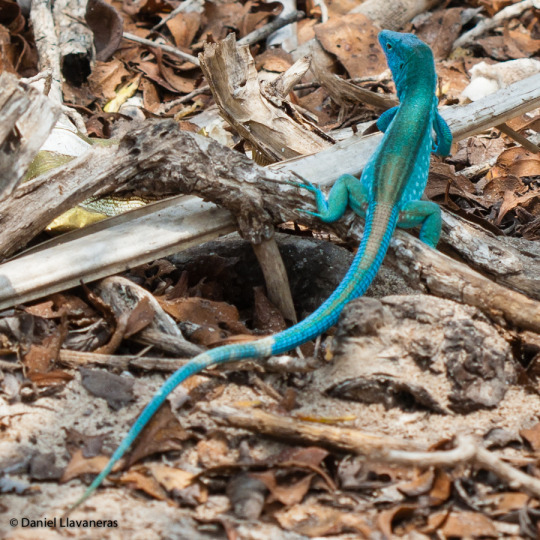Observation of the Week, 7/20/16

This Rainbow Whiptail seen by @dllavaneras in Venezuela is our Observation of the Week!
An entomologist living and working in Venezuela, Daniel Llavaneras and fellow members of ConBiVe (a non-profit dedicated to the conservation of Venezuelan biodiversity) recently went on an exploratory research trip to Venezuela’s San Esteban National Park. On the last day of their visit, they went to Isla Larga, which is just off the coast. “We saw a wildlife cornucopia,” he says, “from squids and fishes to sea urchins and feather duster worms. Once we got out of the water, we thought that the wildlife surprises were over, and then we saw a blue streak dashing across the sand towards us.” That blue streak was the Rainbow Whiptail pictured above. It approached the group and “started eating the ants that were coming to and from a nearby nest. It gave me enough time to pull out my camera and shoot a few frames before some enthusiastic tourists approached it too quickly and it ran away.”
Rainbow Whiptails are quick, vibrantly-colored lizards native to the Caribbean, Central America and South America, and have now become established in Florida. Some populations of this lizard and other members of its genus are all-female or mostly female and reproduce by parthenogenesis (laying unfertilized eggs), and they have been known to engage in pseudocopulation, in which two females engage in mating-like behavior.
Daniel’s interest in natural history began during childhood (“I still have the newspaper clipping when Cryolophosaurus ellioti was published; it amazed me that dinosaurs could be found in what is now Antarctica,” he says), and his current main interests include urban biodiversity and citizen science/outreach. “The incredible diversity of animals that thrive (or at least still survive) in an increasingly urbanized area is something that greatly interests me,” he says. Daniel’s been following the rise and fall of different species in and around Caracas, noting that while he hasn’t seen a spreadwing damselfly (once common) in five years, other animals like macaws, sloths and even frogs can be found in abundance in certain areas. “The number of species that I’ve found in my house since I moved three years ago is over 100, most being insects and spiders, but also geckos and birds, including one stray vulture (I live on a 6th floor).”
Daniel only recently joined iNaturalist, after hearing about it from a colleague, but says that using iNaturalist has already “cemented and refined the way I document my wildlife observations. My notes always include behavior and other miscellaneous tidbits, but they sometimes stay in my field notebook for weeks or months, with many organisms without IDs. By uploading to iNaturalist I can get help from other colleagues around the world, and I can also help with citizen science, an area that I really enjoy.” He’s optimistic that through citizen science and other forms of outreach, “people [will] realize that there is a lot to gain with conservation and ecotourism.”
by Tony Iwane
- You can follow Daniel on Twitter and Instagram, and he says he’s happy to help with insect IDs and answer questions.
- Here’s a paper Daniel helped with, looking into whether or not sylvatic bugs are becoming associated with human dwellings.





Comments
Great work! Gorgeous image.
Just wanted to say there is a word missing (maybe the word genus, or the word family?) in this sentence "Some populations of this lizard and other members of its (?) are all-female or mostly female ".
Whoops, thanks @susanhewitt! Should be corrected now.
Add a Comment